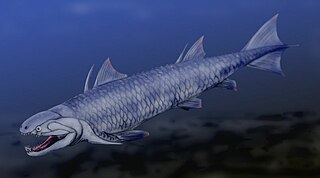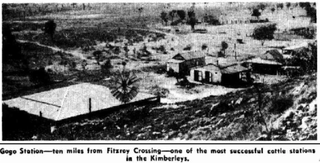
Lungfish are freshwater vertebrates belonging to the class Dipnoi. Lungfish are best known for retaining ancestral characteristics within the Osteichthyes, including the ability to breathe air, and ancestral structures within Sarcopterygii, including the presence of lobed fins with a well-developed internal skeleton. Lungfish represent the closest living relatives of the tetrapods. The mouths of lungfish typically bear tooth plates, which are used to crush hard shelled organisms.

Neoceratodus is a genus of lungfish in the family Neoceratodontidae. The extant Australian lungfish is the only surviving member of this genus, but it was formerly much more widespread, being distributed throughout Africa, Australia, and South America. Species were also much more diverse in body plan; for example, the Cretaceous species Neoceratodus africanus was a gigantic species that coexisted with Spinosaurus in what is now the Kem Kem Formation of Morocco. The earliest fossils from this genus are of Neoceratodus potkooroki from the mid Cretaceous (Albian-Cenomanian) Griman Creek Formation of Australia; remains from the Late Jurassic of Uruguay assigned to this genus probably do not belong to the genus.

Psarolepis is a genus of extinct bony fish which lived around 397 to 418 million years ago. Fossils of Psarolepis have been found mainly in South China and described by paleontologist Xiaobo Yu in 1998. It is not known certainly in which group Psarolepis belongs, but paleontologists agree that it probably is a basal genus and seems to be close to the common ancestor of lobe-finned and ray-finned fishes. In 2001, paleontologist John A. Long compared Psarolepis with onychodontiform fishes and refer to their relationships.

Onychodus is a genus of prehistoric lobe-finned fish which lived during the Devonian Period. It is one of the best known of the group of onychodontiform fishes. Scattered fossil teeth of Onychodus were first described from Ohio in 1857 by John Strong Newberry. Other species were found in Australia, England, Norway and Germany showing that it had a widespread range.

The Gogo Formation in the Kimberley region of Western Australia is a Lagerstätte that exhibits exceptional preservation of a Devonian reef community. The formation is named after Gogo Station, a cattle station where outcrops appear and fossils are often collected from, as is nearby Fossil Downs Station.
The Xitun Formation is a palaeontological formation which is named after Xitun village in Qujing, a location in South China. This formation includes many remains of fossilized fish and plants of the Early Devonian period. It was originally referred to as the Xitun Member of the Cuifengshan Formation.

Holonema is an extinct genus of relatively large, barrel-shaped arthrodire placoderms that were found in oceans throughout the world from the Mid to Late Devonian, when the last species perished in the Frasnian-Fammian extinction event. Most species of the genus are known from fragments of their armor, but the Gogo Reef species, H. westolli, is known from whole, articulated specimens.
Ferganoceratodus is a genus of prehistoric lungfish known from the Mesozoic of Asia. Based on morphological evidence, it has either been recovered as a basal member of the Ceratodontiformes or to be the sister group of the Neoceratodontidae.
Gogodipterus is an extinct genus of prehistoric marine lungfish in the family Chirodipteridae. It contains a single species, G. paddyensis, known from the Late Devonian Gogo Formation of Western Australia. It was formerly placed in Chirodipterus.
Ganopristodus is an extinct genus of prehistoric sarcopterygian or lobe-finned fish from the Devonian.
Iowadipterus is an extinct genus of prehistoric sarcopterygian or lobe-finned fish.
Mioceratodus is an extinct genus of lungfish in the family Neoceratodontidae, which also contains the extant Queensland lungfish. It is known only from Oligocene and Miocene-aged sediments in Australia, although phylogenetic evidence supports it having first diverged from its closest relative, Neoceratodus, during the Late Jurassic or Early Cretaceous period.

Ptychoceratodus is an extinct genus of lungfish living from Early Triassic to Middle Jurassic. It was established by Otto Jaekel for one species, transferred from Ceratodus genus. Type species is P. serratus from the Middle Triassic of Switzerland and Germany. Ptychoceratodus had two pairs of massive dental plates, bearing 4-6 acute ridges. Its skull roof was composed from massive, plate-like bones. In the central part of skull roof was localized an unossified fenestra. Most of the Ptychoceratodus findings are isolated dental plates, some associated with jaws. Other parts of skull or postcranial skeleton are relatively rarely found as fossils. The anatomy of skull is the best recognized in P. serratus, whereas less complete cranial material is available also for P. concinuus, P. phillipsi, and P. rectangulus. Although Ptychoceratodus is known exclusively from the Triassic and Jurassic, there were also Cretaceous specimens referred to this genus. However, they are more often regarded as representants of Metaceratodus. Ptychoceratodus is the only member of the family Ptychoceratodontidae. The first named species is P. phillipsi by Louis Agassiz in 1837 as a species of Ceratodus and later moved to Ptychoceratodus genus. Occurrences of Ptychoceratodus come mainly from Europe. However, occurrences from other continents suggest it was dispersed globally during the Triassic. After 2010, the new fossil material behind the Europe was reported from South America, India, and Greenland
Westollrhynchus is an extinct genus of prehistoric sarcopterygians or lobe-finned fish containing only one recognized species, Westrollrhynchus lehmanni.
Sorbitorhynchus is an extinct genus of prehistoric sarcopterygians, or lobe-finned fish. Fossils of this genus of marine lungfish have been found in Guangxi, China. The only described species in this genus is Sorbitorhynchus deleaskitus, but the holotype for this species may show some unusual malformations and thus not be useful for taxonomic or phylogenetic analysis.
Xeradipterus is an extinct genus of lungfish which existed in Australia during the Frasnian period. Of moderate size, it is believed to be a primitive member of the family Holodontidae characterized by its powerful crushing dentition with thick heels on the lower jaw tooth plates. The type and only specimen was found in the Gogo Formation by Lindsay Hatcher on an expedition to Gogo led by John A. Long on behalf of Museum Victoria in 2005.
The Wood Bay Series is a geologic formation found on the island of Spitsbergen, Svalbard in Norway. It preserves fossils dating back to the Pragian–Emsian stages of the Devonian period.

Ceratodontiformes is the only extant order of lungfish, containing the families Neoceratodontidae, Lepidosirenidae, and Protopteridae as well as many other extinct groups. Members of this group are the only lungfish known to have survived the Permian-Triassic extinction event. Although lungfish originated in marine environments, the Ceratodontiformes have been an exclusively freshwater group since the Carboniferous. This order was formerly considered the suborder Ceratodontoidei.

Phoebodus is an extinct genus of phoebodontiform total group elasmobranch, known from over a dozen species found worldwide spanning the middle to late Devonian, making it one of the oldest known total group elasmobranchs. Most species are only known from their isolated tricuspid teeth, but one species, Phoebodus saidselachus from the Late Devonian of Morocco, is known from a complete skeleton, estimated to have been 1.2 metres (3.9 ft) in total length in life, which shows that it had a slender body superficially similar to that of the living frilled shark. The teeth of Phoebodus and frilled sharks are also morphologically similar, and are designed for grasping prey. Phoebodus probably consumed small prey items that were capable of being swallowed whole.













